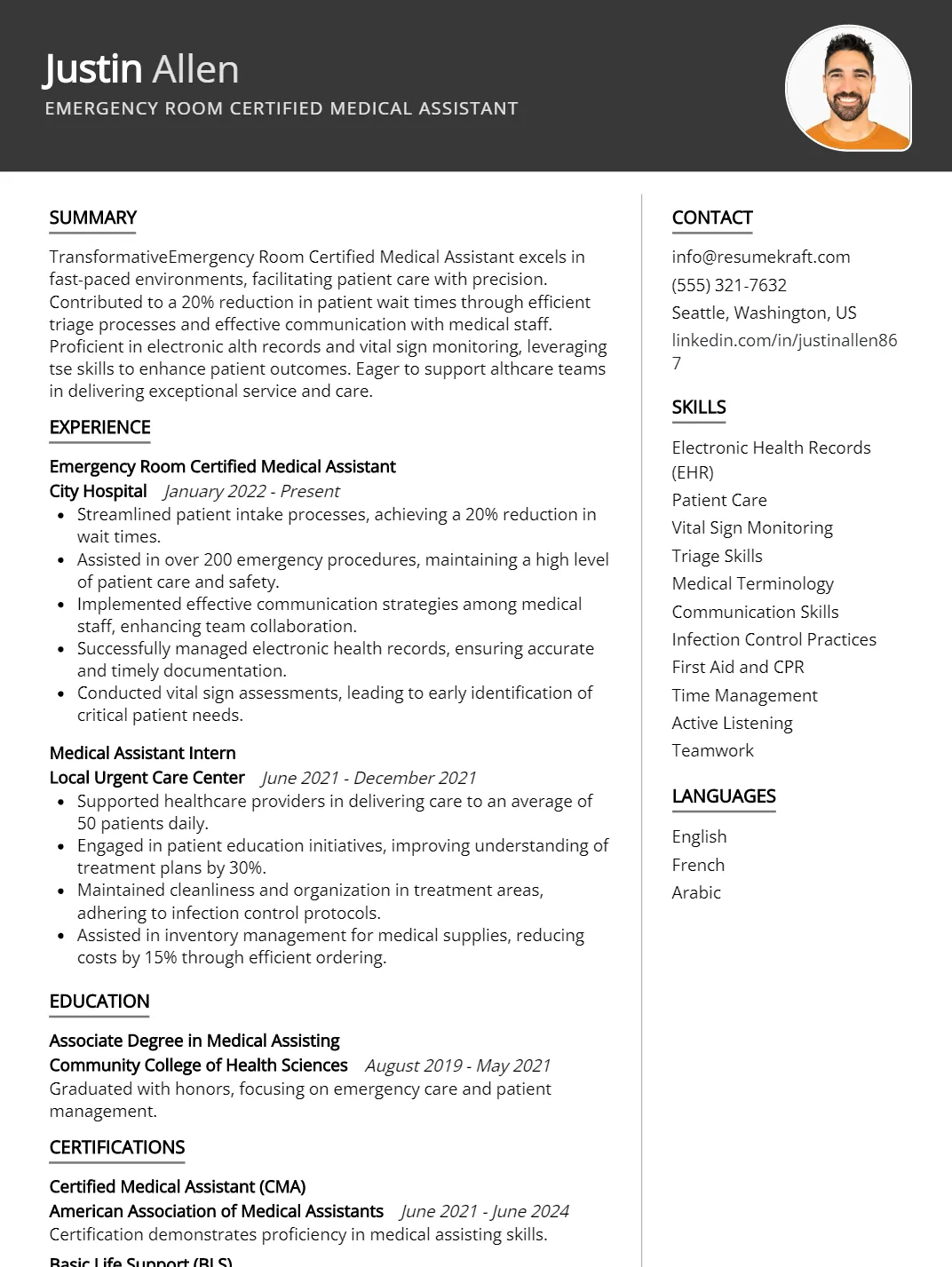
The role of a Medical Assistant is pivotal in the healthcare industry, serving as a vital link between patients and healthcare providers. Medical Assistants perform a range of clinical and administrative tasks, including taking patient histories, assisting in examinations, and managing medical records. As the demand for healthcare services continues to rise, the need for skilled Medical Assistants has never been more critical in today’s job market. This article aims to provide insights into crafting an effective resume that highlights the unique skills and qualifications necessary for aspiring Medical Assistants to stand out in their job search.
- Medical Assistant resume examples
- How to format a Medical Assistant resume
- How to write your Medical Assistant resume experience
- How to list your hard skills and soft skills on your resume
- How to list your certifications and education on your resume
- How to write your Medical Assistant resume summary or objective
- Additional sections for a Medical Assistant resume
- Key takeaways for writing a professional Medical Assistant resume
- Frequently Asked Questions
Medical Assistant resume examples
Medical Assistant resume examples serve as valuable resources for job seekers aiming to highlight their skills and experience in the healthcare field. By reviewing these examples, candidates can gain insights into effective formatting, key qualifications, and impactful language that resonate with potential employers. Understanding what makes a standout resume for this specific role can significantly enhance a candidate’s chances of securing interviews and landing the desired position.
Medical Assistant Resume
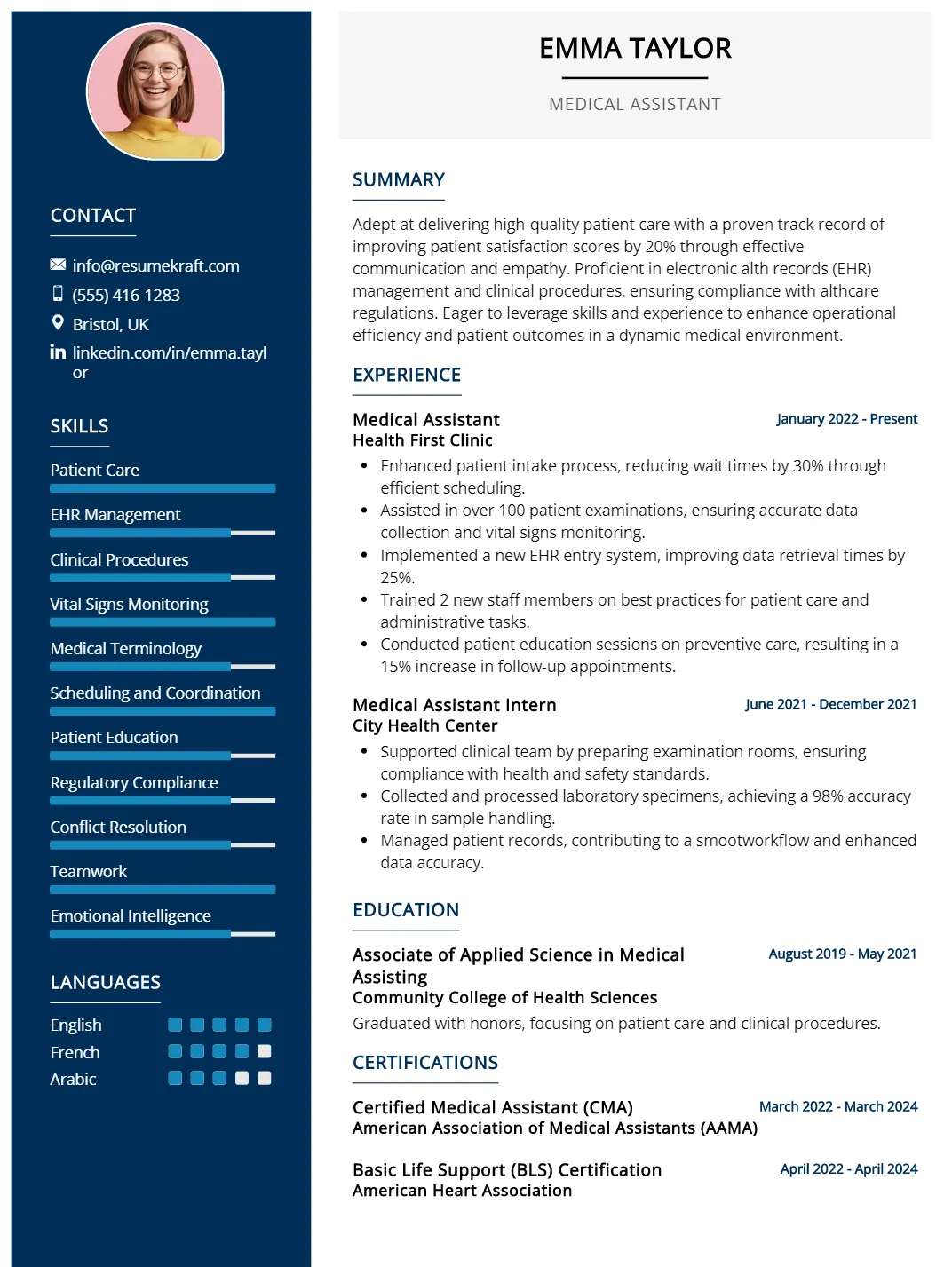
Why This Resume Works
This resume effectively highlights the candidate’s relevant skills and experience for a Medical Assistant position, showcasing expertise in patient care, EHR management, and clinical procedures. The structured format allows for easy navigation, emphasizing key competencies that align with industry expectations. Additionally, the use of specific medical terminology enhances ATS compatibility, ensuring visibility in applicant tracking systems. By strategically presenting achievements related to vital signs monitoring and patient interaction, this resume positions the candidate as a strong contender in the healthcare field.
Certified Medical Assistant Resume
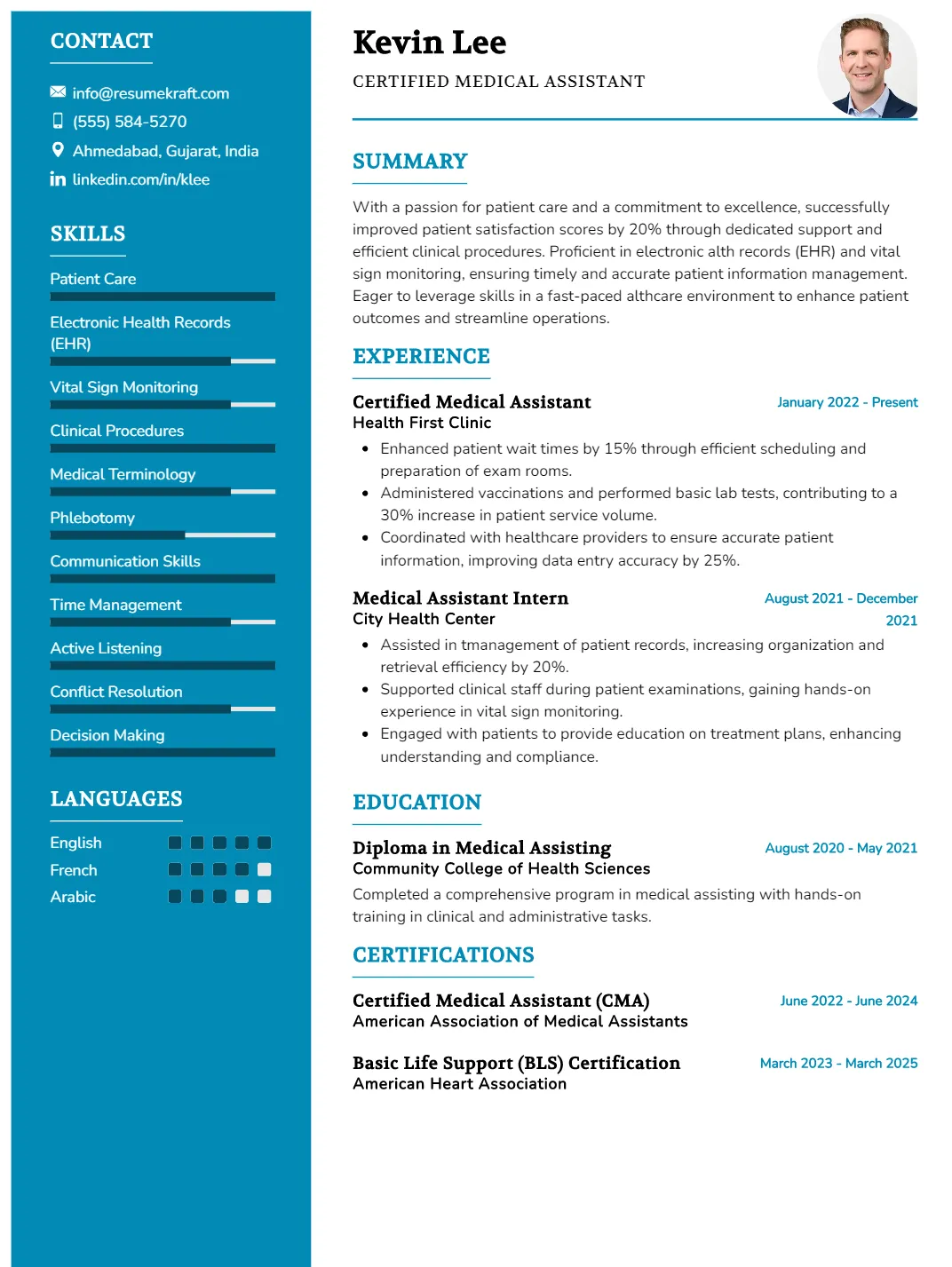
Why This Resume Works
This resume effectively showcases the candidate’s qualifications for a Certified Medical Assistant position by highlighting essential skills such as patient care, EHR proficiency, and clinical procedures. With approximately three years of relevant experience, it presents a strong foundation in both practical knowledge and medical terminology. The structured format enhances readability, ensuring key information is easily accessible. Additionally, the use of industry-specific keywords ensures ATS compatibility, while strategically presented achievements demonstrate the candidate’s impact in previous roles, making them an ideal fit for this position.
Entry-Level Medical Assistant Resume
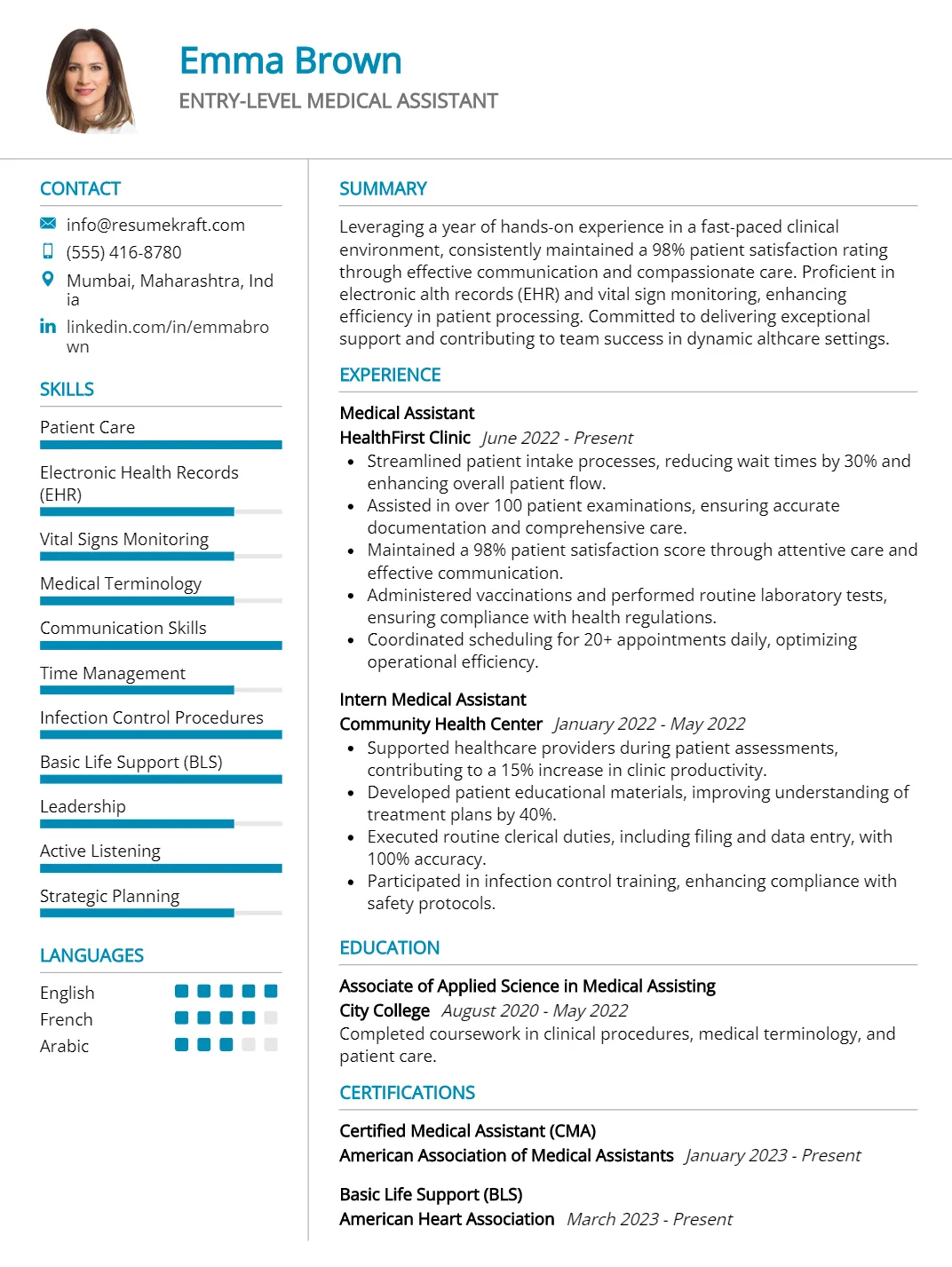
Why This Resume Works
This resume is effective for an Entry-Level Medical Assistant position due to its clear emphasis on relevant skills such as Patient Care, EHR proficiency, and vital signs monitoring. With approximately three years of experience, including internships, it showcases practical knowledge essential for the role. The format is structured for easy readability, enhancing ATS compatibility by incorporating industry-specific keywords. Additionally, strategic presentation of achievements related to patient interactions and technical competencies highlights the candidate’s readiness to contribute meaningfully in a clinical setting.
Junior Certified Medical Assistant Resume
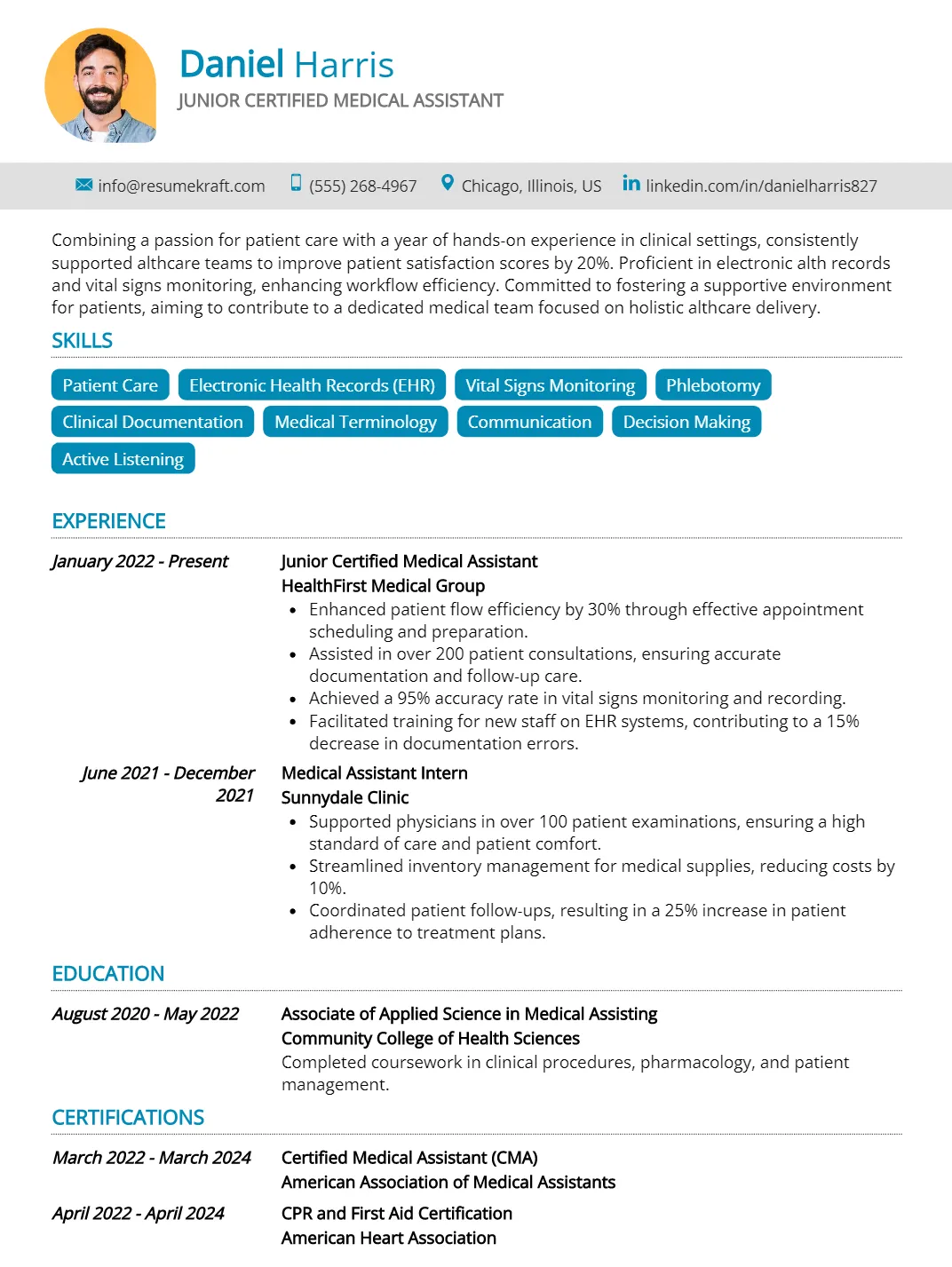
Why This Resume Works
This resume effectively highlights the candidate’s relevant skills and experience for a Junior Certified Medical Assistant position, showcasing expertise in patient care, EHR management, and vital signs monitoring. The structured format presents information clearly, enhancing readability for hiring managers. It is optimized for ATS compatibility, ensuring key terms like “phlebotomy” and “clinical documentation” are easily recognized. Additionally, the strategic presentation of internships and certifications emphasizes practical achievements that align with industry standards, making it a compelling choice for potential employers.
Medical Assistant Intern Resume
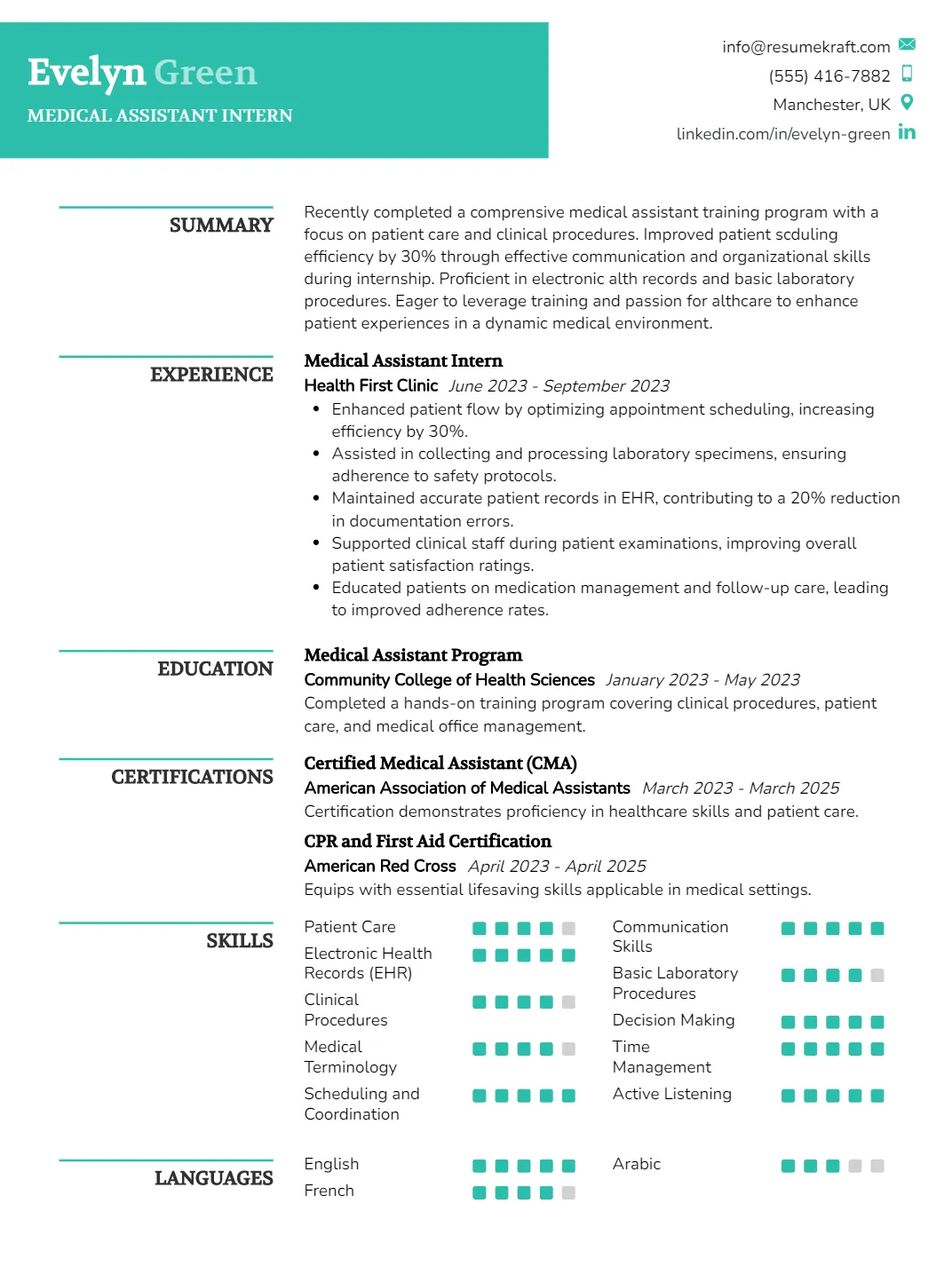
Why This Resume Works
This resume effectively highlights the candidate’s relevant skills, such as patient care and proficiency in Electronic Health Records (EHR), making it ideal for a Medical Assistant Intern position. Its clear format facilitates quick scanning, showcasing experience in clinical procedures and medical terminology, which are crucial for the role. The structured presentation aligns with ATS compatibility by incorporating industry-specific keywords. Additionally, emphasizing achievements related to scheduling and coordination demonstrates the candidate’s proactive approach to enhancing patient care, further strengthening their suitability for the position.
Emergency Room Certified Medical Assistant Resume

Why This Resume Works
This resume effectively positions the candidate for an Emergency Room Certified Medical Assistant role by highlighting relevant skills such as EHR, patient care, and triage expertise. With approximately three years of experience directly in emergency settings, it demonstrates practical knowledge essential for high-pressure environments. The structured format enhances readability, ensuring quick access to critical information. Additionally, the inclusion of industry-specific keywords ensures ATS compatibility, while strategically presented achievements reflect their direct impact on patient outcomes—vital for this fast-paced field.
Medical Office Assistant Resume
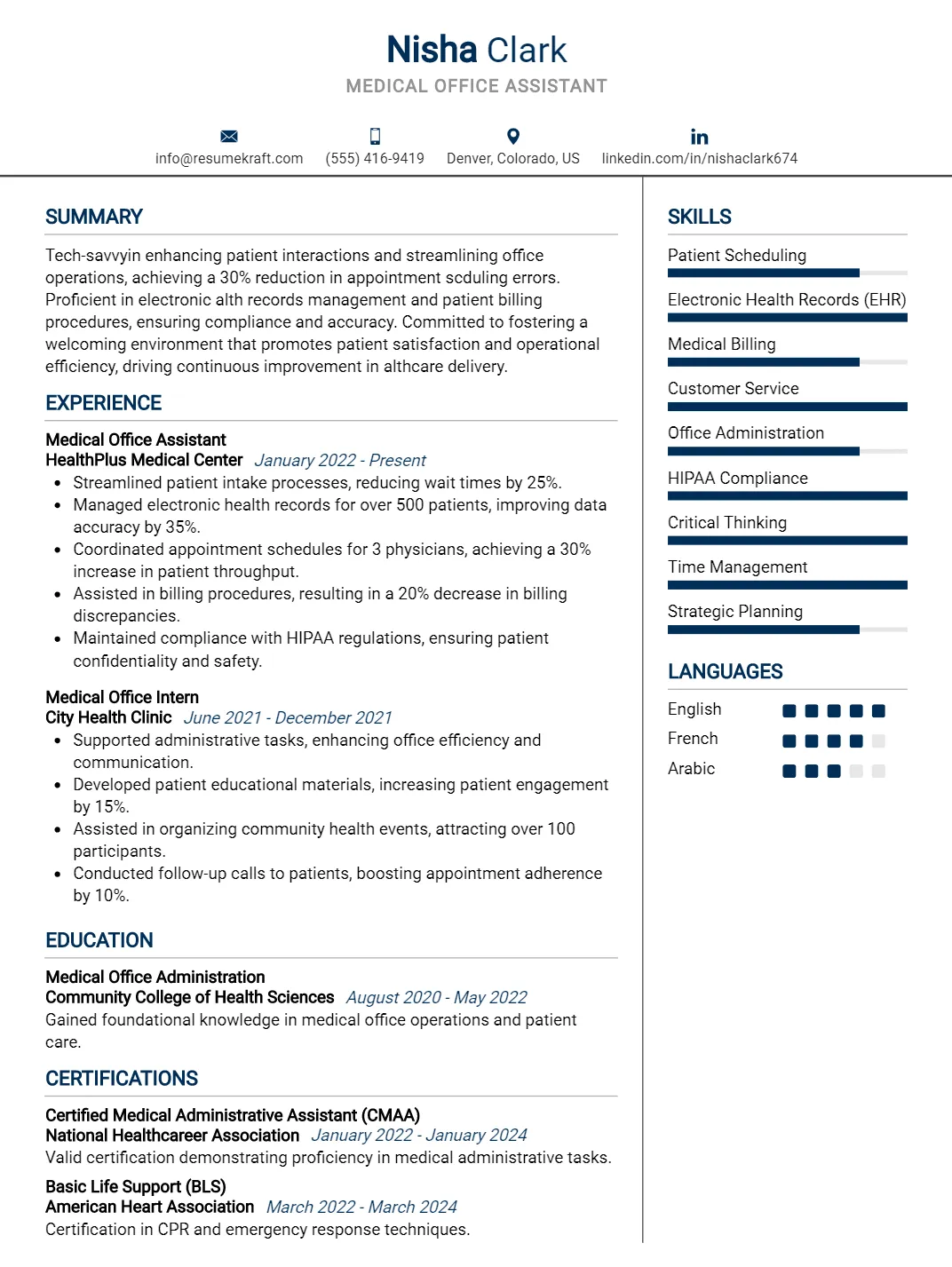
Why This Resume Works
This resume effectively showcases the candidate’s qualifications for a Medical Office Assistant position through a targeted list of relevant skills, including Patient Scheduling and Electronic Health Records expertise. With three years of experience in both assistant and intern roles, it highlights practical knowledge essential for the job. The clear format enhances readability, ensuring ATS compatibility by utilizing industry-specific keywords. Additionally, strategic emphasis on achievements in medical billing and customer service demonstrates the candidate’s ability to contribute positively to patient care and office efficiency.
Medical Administrative Assistant Resume
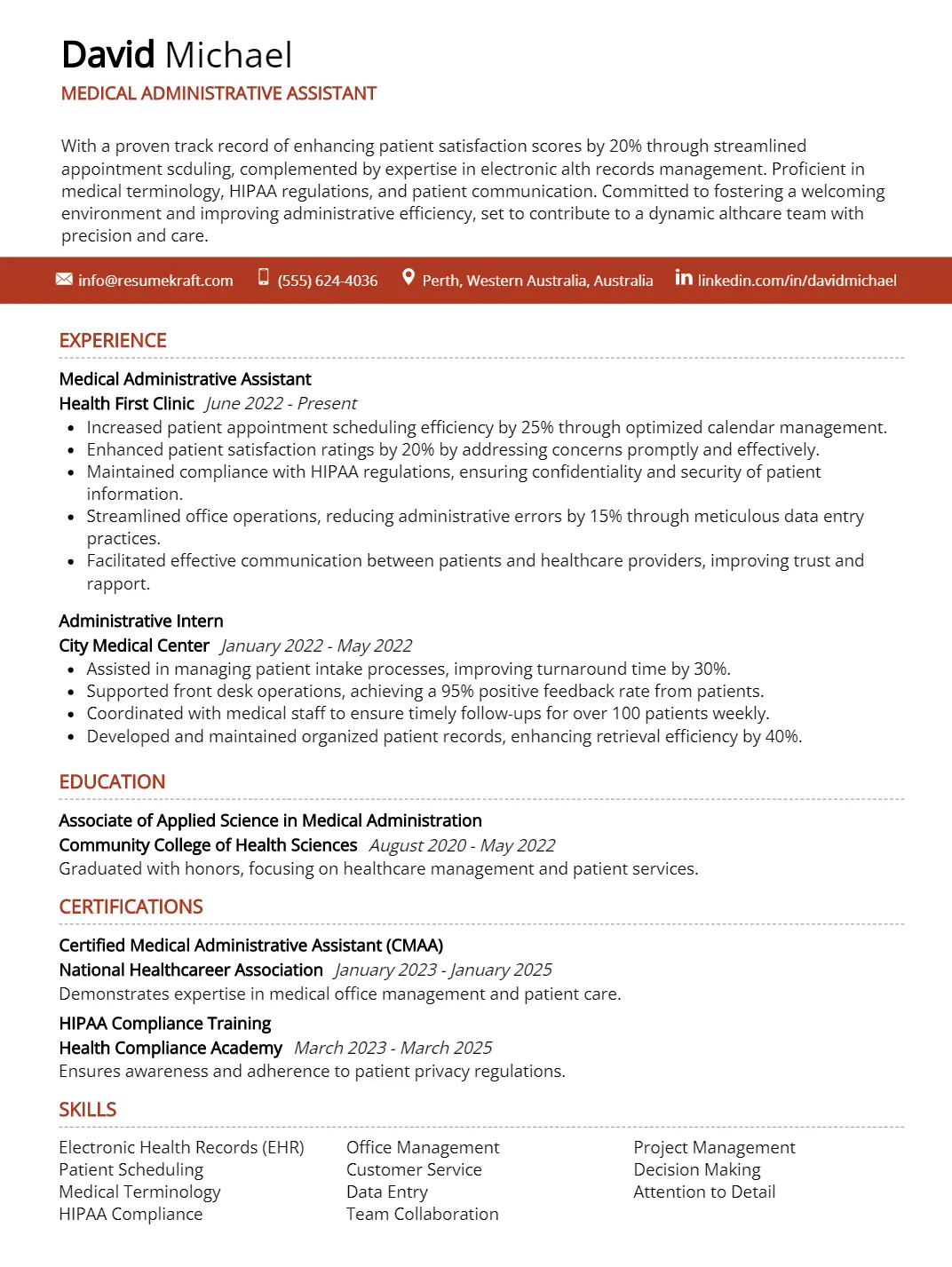
Why This Resume Works
This resume effectively highlights the candidate’s relevant skills, such as Electronic Health Records and HIPAA compliance, directly aligning with the demands of a Medical Administrative Assistant. With three years of experience, including an administrative internship, it showcases a solid foundation in office management and patient interactions. The structured format enhances readability for hiring managers and ensures compatibility with Applicant Tracking Systems (ATS) by incorporating industry-specific keywords.
Medical Office Reception Supervisor Resume
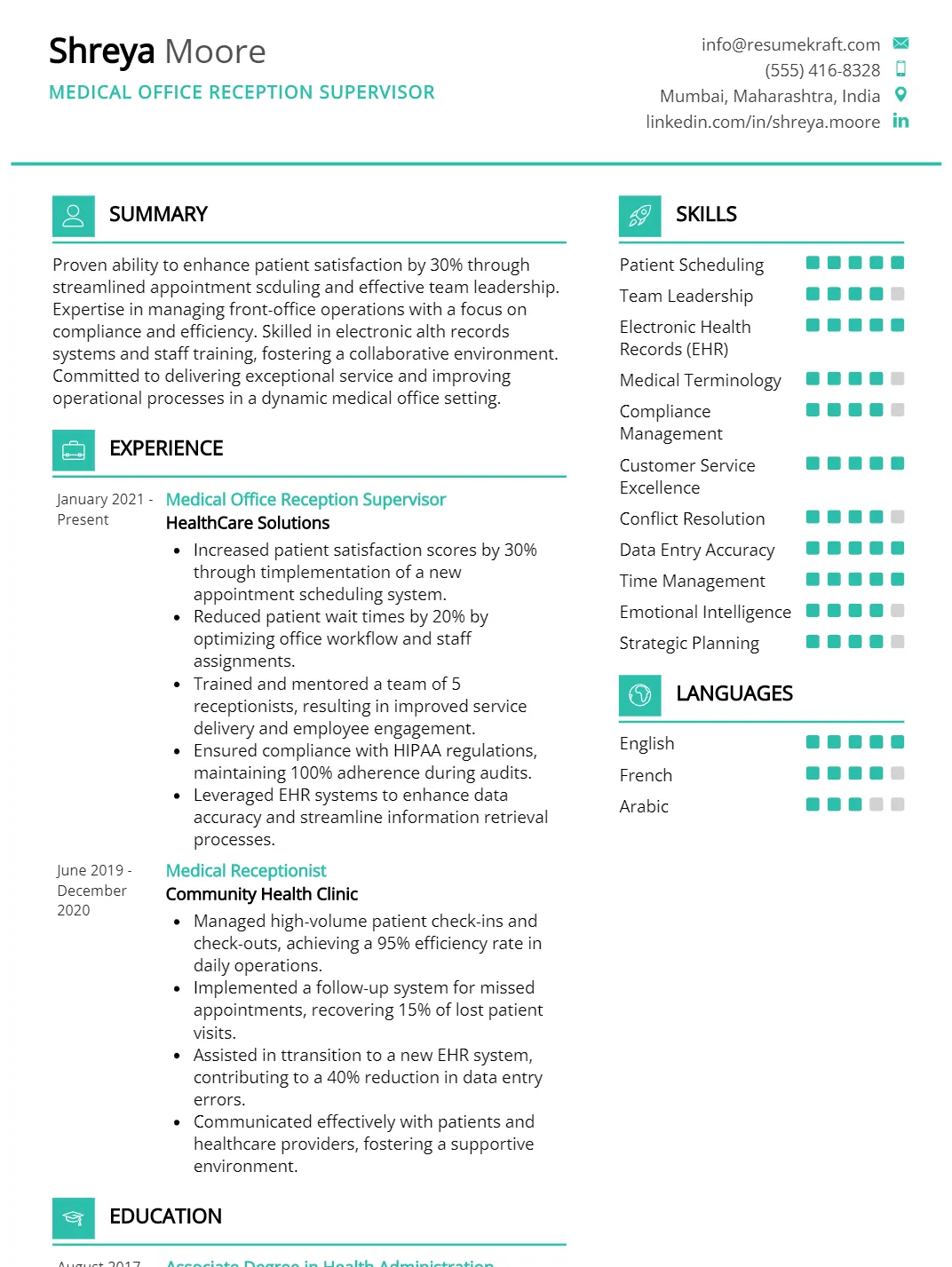
Why This Resume Works
This resume effectively positions the candidate for the Medical Office Reception Supervisor role by highlighting relevant skills such as patient scheduling, team leadership, and compliance management. With five years of experience in medical reception, it demonstrates a clear career progression and proficiency in Electronic Health Records (EHR) and medical terminology. The format is structured for easy readability, ensuring ATS compatibility. Additionally, strategic presentation of achievements showcases the candidate’s contributions to office efficiency and patient satisfaction—key metrics in this profession.
Advanced Medical Office Specialist Resume

Why This Resume Works
This resume effectively highlights the candidate’s six years of relevant experience as an Advanced Medical Office Specialist, showcasing essential skills like EHR management and medical coding that directly align with the job requirements. The clear format enhances readability, making it easy for hiring managers to quickly identify key qualifications. Additionally, its structured keywords ensure compatibility with Applicant Tracking Systems (ATS), increasing visibility.
Medical Administrative Operations Specialist Resume
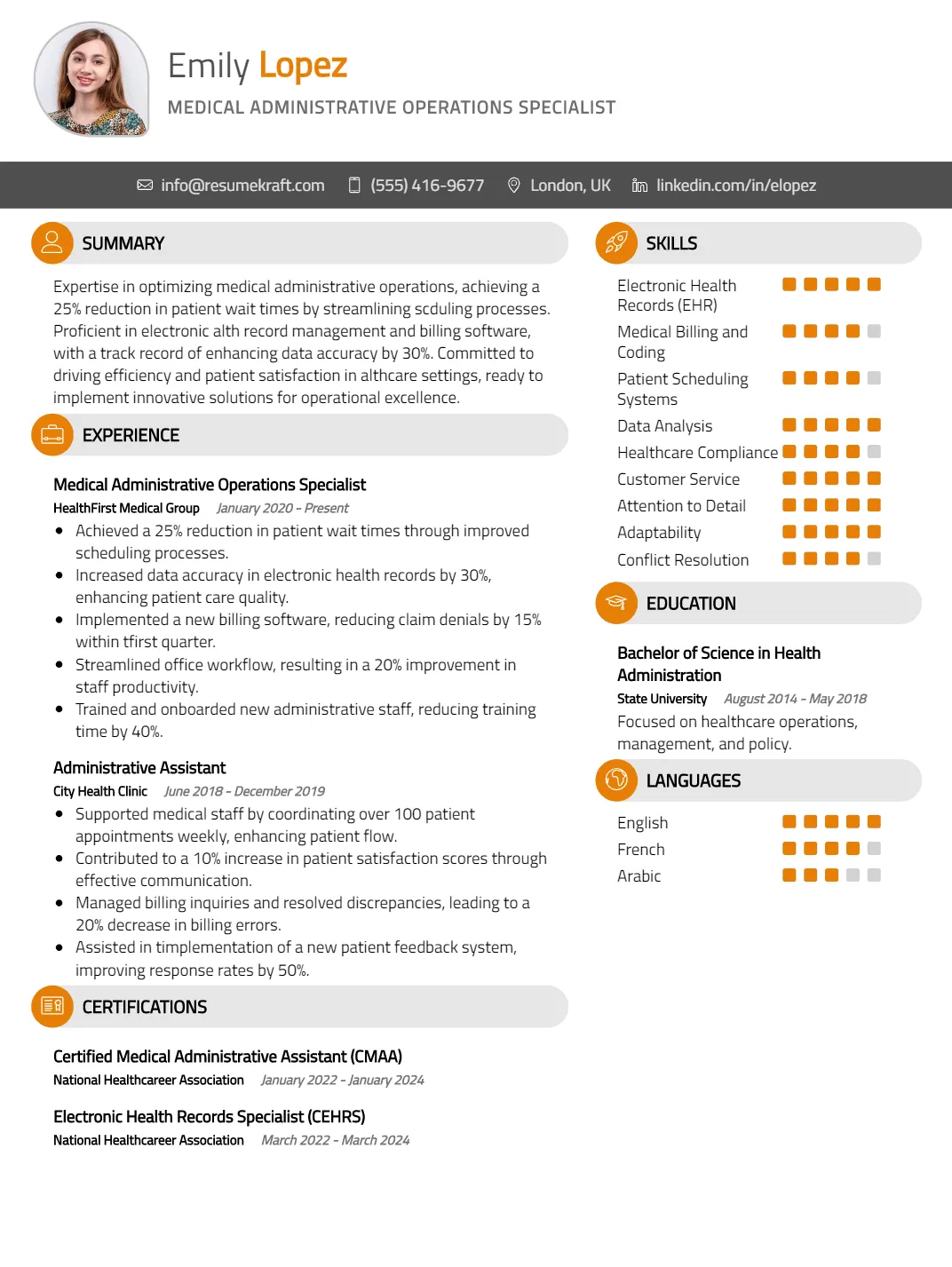
Why This Resume Works
This resume effectively highlights the candidate’s relevant skills, such as EHR management and medical billing, directly aligning with the Medical Administrative Operations Specialist position. Its clear format emphasizes key accomplishments in administrative roles, showcasing expertise in patient scheduling and healthcare compliance. The structured layout enhances readability for hiring managers while ensuring ATS compatibility by incorporating industry-specific keywords. Additionally, the strategic presentation of achievements demonstrates measurable impact, making this resume stand out in a competitive healthcare job market.
Medical Equipment Specialist Resume
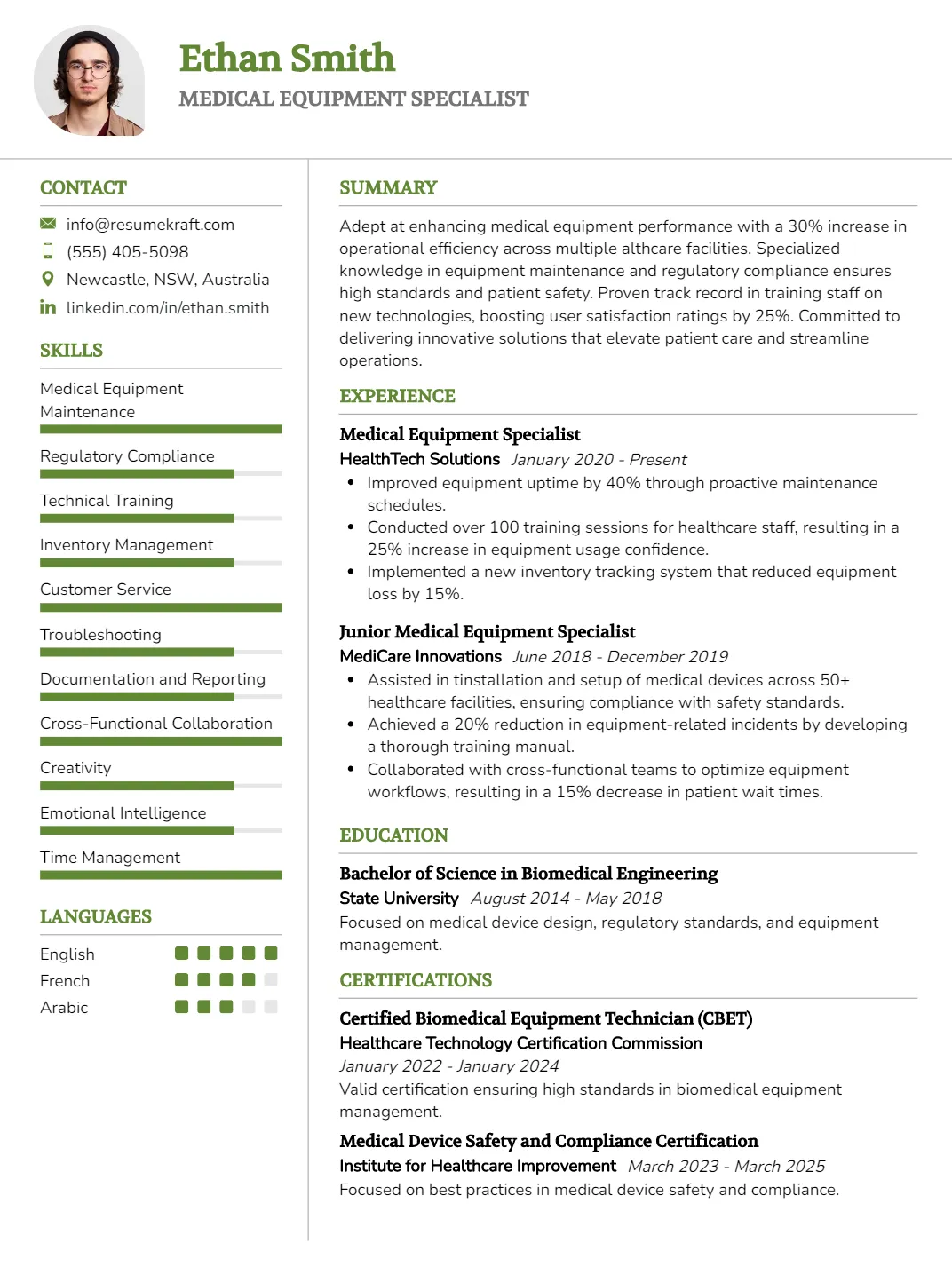
Why This Resume Works
This resume effectively highlights the candidate’s six years of relevant experience as a Medical Equipment Specialist and Junior Medical Equipment Specialist, showcasing essential skills like Medical Equipment Maintenance and Regulatory Compliance. Its structured format emphasizes these key competencies, making it easy for hiring managers to assess qualifications quickly. Additionally, the inclusion of industry-specific keywords enhances ATS compatibility. Strategic presentation of achievements demonstrates measurable impact in previous roles, reinforcing the candidate’s capability to excel in ensuring equipment reliability and customer satisfaction within the medical field.
Medical Office Coordinator Resume
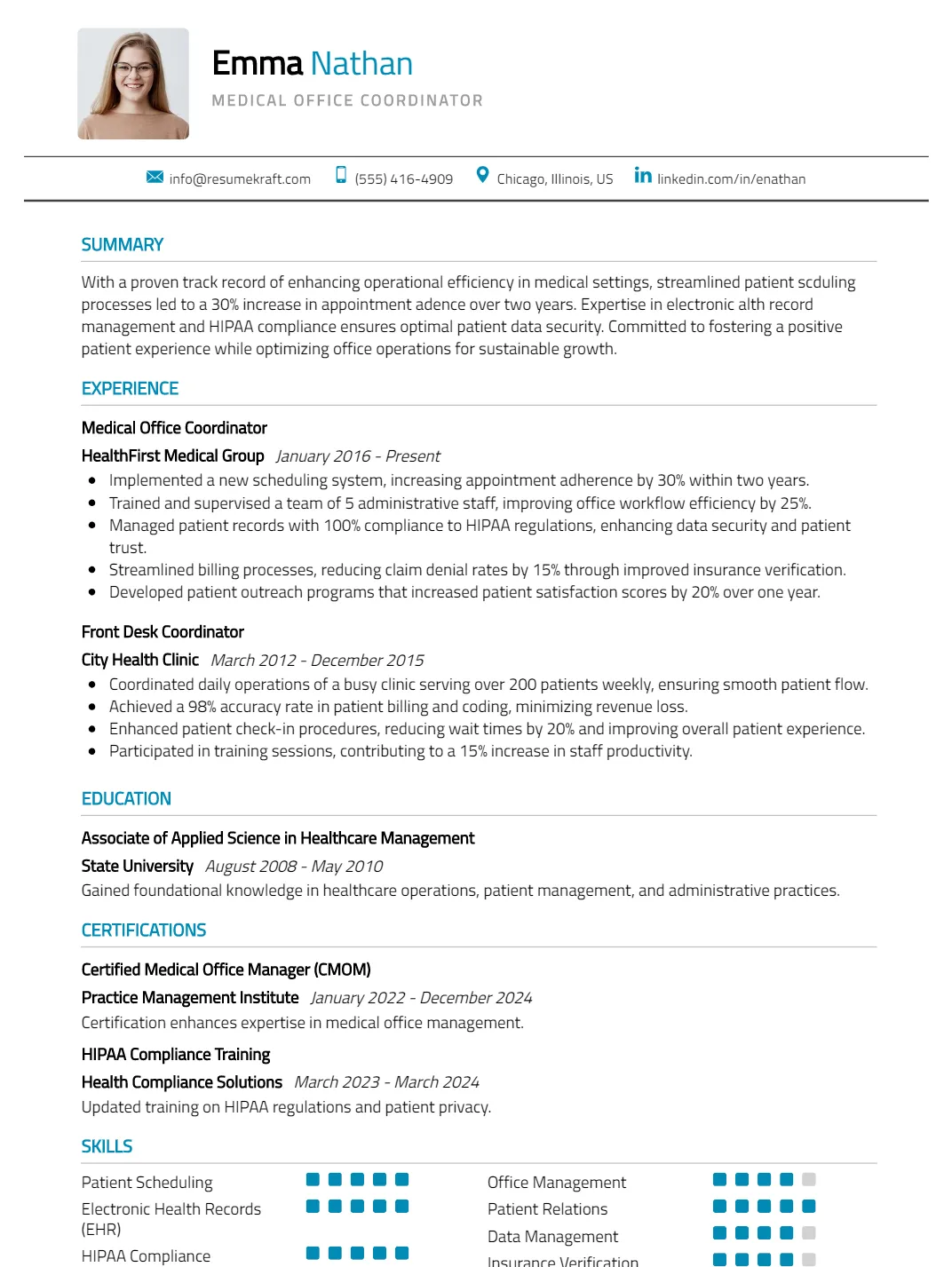
Why This Resume Works
This resume effectively showcases the candidate’s extensive 12 years of experience as a Medical Office Coordinator and Front Desk Coordinator, highlighting essential skills such as patient scheduling, EHR management, and HIPAA compliance. Its structured format emphasizes key competencies relevant to the role while ensuring clarity for hiring managers. Additionally, the use of industry-specific keywords enhances ATS compatibility. Strategic achievements in billing and coding further demonstrate the candidate’s capability to contribute to office efficiency and patient care, making this resume particularly compelling for the position.
Non-Certified Medical Assistant Resume

Why This Resume Works
This resume effectively targets the Non-Certified Medical Assistant position by highlighting relevant skills such as patient care, EHR proficiency, and clinical procedures. The structured format presents experience clearly, showcasing approximately two years in roles directly related to the job. Its compatibility with Applicant Tracking Systems (ATS) is ensured through the use of industry-specific keywords. Additionally, strategic presentation of achievements emphasizes vital signs monitoring and communication skills, which are critical for success in this field, making it a compelling choice for hiring managers.
Medical Assistant Intern Resume
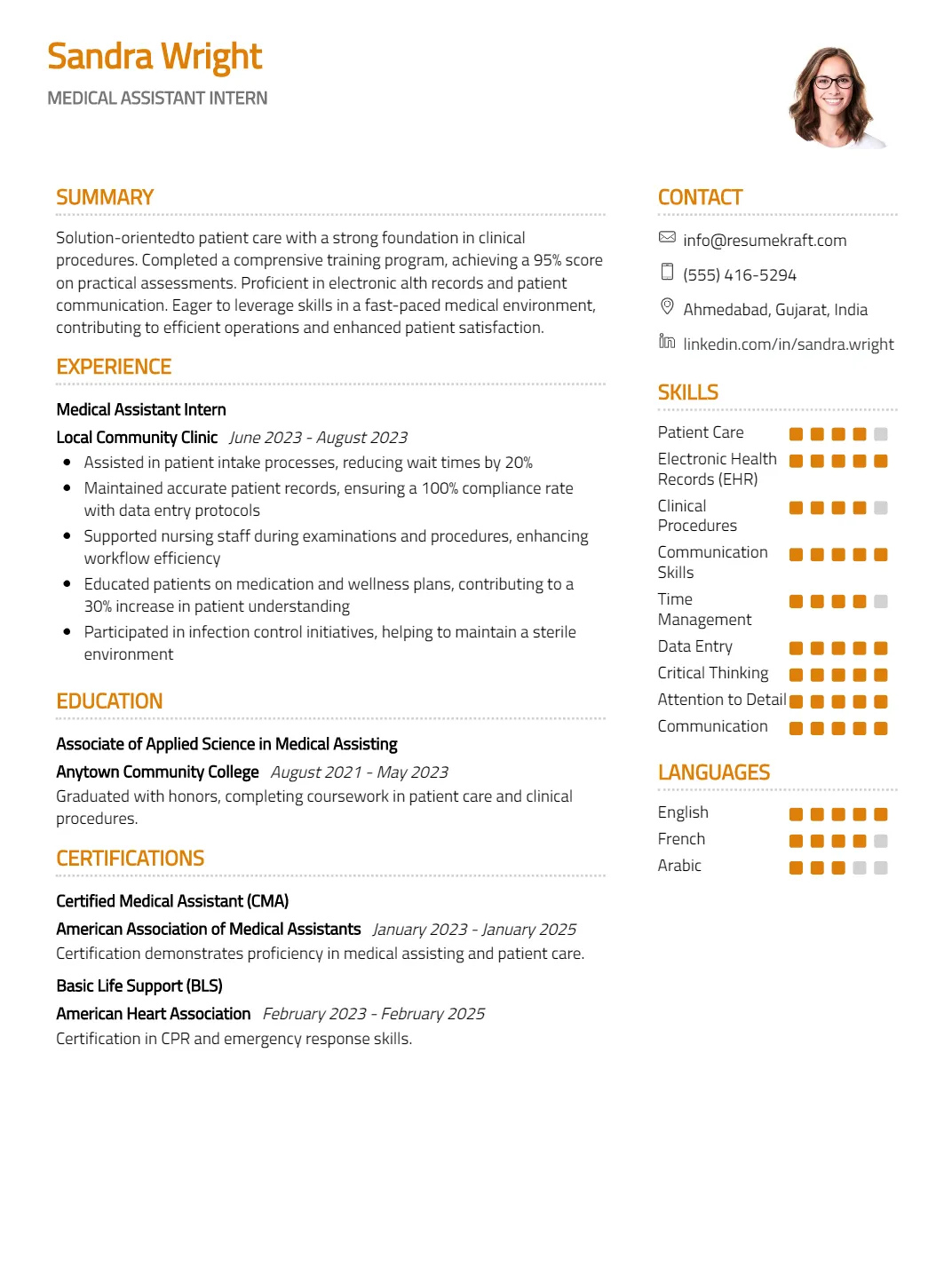
Why This Resume Works
This resume effectively highlights the candidate’s relevant skills, such as patient care and proficiency in Electronic Health Records (EHR), which are essential for a Medical Assistant Intern. The structured format clearly presents experience and key competencies, making it easy for hiring managers to assess qualifications quickly. Additionally, the use of industry-specific keywords enhances ATS compatibility, ensuring visibility during automated screenings. By strategically showcasing achievements in clinical procedures and communication, this resume aligns well with the expectations of healthcare employers.
How to format a Medical Assistant resume
Proper formatting for a Medical Assistant resume is crucial as it enhances readability and showcases your qualifications effectively. A well-structured resume format can significantly influence hiring managers, making it easier for them to recognize your skills and experience.
- Use a clean, professional font such as Arial or Calibri in 10-12 point size to ensure readability and maintain a polished appearance throughout your resume.
- Organize your resume into clear sections, including Contact Information, Summary, Skills, Experience, and Education, allowing hiring managers to quickly locate relevant information.
- Utilize bullet points for job responsibilities and achievements to enhance readability, making it easier for employers to scan your qualifications at a glance.
- Keep your resume to one page for concise communication, especially if you have less than five years of experience, ensuring only the most relevant information is highlighted.
- Include specific Medical Assistant skills, such as patient care and administrative tasks, prominently in your Skills section, ensuring they align with the job description to attract attention.
How to write your Medical Assistant resume experience
Effectively presenting work experience on a Medical Assistant resume is crucial, as this section showcases your practical skills and accomplishments in a clinical setting. Employers seek candidates who not only possess the necessary certifications but also demonstrate hands-on experience with patient care, administrative tasks, and relevant medical procedures.
A well-crafted experience section can set you apart, highlighting your ability to contribute to a healthcare team and improve patient outcomes. It is essential to quantify your achievements and provide context, allowing employers to gauge the impact of your work.
Worked as a Medical Assistant. Helped patients and did some paperwork.
Assisted over 100 patients daily in a fast-paced clinic, managed electronic health records, and streamlined appointment scheduling, increasing patient satisfaction scores by 20%.
How to list your hard skills and soft skills on your resume
In the competitive field of healthcare, a Medical Assistant’s resume must effectively showcase both hard and soft skills. Hard skills are essential technical abilities that demonstrate your proficiency in specific tasks, such as clinical procedures and administrative functions. Conversely, soft skills highlight your interpersonal attributes, which are crucial when interacting with patients and healthcare teams. Together, these skill sets create a well-rounded candidate capable of providing high-quality care and support in a fast-paced environment.
Hard Skills:
- Clinical procedures: Ability to perform tasks like taking vital signs, drawing blood, and administering injections.
- Medical terminology: Knowledge of medical vocabulary to communicate effectively with healthcare professionals.
- Patient care: Skills in assisting patients with their needs before and during examinations.
- Electronic Health Record (EHR) management: Proficiency in using software to maintain patient records.
- Inventory management: Ability to track and manage medical supplies to ensure availability.
- Phlebotomy: Skilled in drawing blood for tests and samples.
- Basic life support (BLS): Certification and knowledge of CPR and emergency response techniques.
- Medication administration: Understanding how to prepare and administer medications correctly.
- Medical coding: Familiarity with coding systems used for billing and insurance purposes.
- Scheduling: Experience in managing appointments and coordinating patient visits.
- Lab procedures: Knowledge in performing basic laboratory tests and understanding results.
- Radiology assistance: Ability to assist in imaging procedures like X-rays.
- Insurance verification: Skills in checking patient insurance coverage and eligibility.
- Patient education: Ability to provide patients with information on treatments and wellness plans.
- HIPAA compliance: Knowledge of regulations to ensure patient confidentiality and data protection.
Soft Skills:
- Communication: Strong verbal and written skills for effective interaction with patients and staff.
- Empathy: Ability to understand and share the feelings of patients, providing compassionate care.
- Attention to detail: Precision in tasks to avoid errors in patient care and documentation.
- Teamwork: Capability to work collaboratively with healthcare professionals to achieve common goals.
- Time management: Skills in prioritizing tasks to ensure efficient workflow in a busy environment.
- Problem-solving: Ability to quickly identify and resolve issues that may arise in patient care.
- Adaptability: Flexibility in adjusting to new protocols, technologies, and medical practices.
- Organization: Strong organizational skills to manage multiple tasks and patient needs simultaneously.
- Interpersonal skills: Ability to build rapport with patients and colleagues to foster a positive environment.
- Stress management: Capability to remain calm and effective under pressure in fast-paced situations.
- Critical thinking: Skills in analyzing situations and making informed decisions regarding patient care.
- Conflict resolution: Ability to address and resolve conflicts effectively with professionalism.
- Leadership: Skills in taking initiative and guiding team members when necessary.
- Patient advocacy: Commitment to representing and supporting patients’ needs and rights.
- Motivation: Self-driven attitude that fosters a proactive approach to patient care and team contribution.
How to list your certifications and education on your resume
When presenting certifications and education on a Medical Assistant resume, it’s essential to highlight relevant qualifications that demonstrate your expertise. Start with your highest degree, such as an Associate’s degree in Medical Assisting, followed by any certifications like the Certified Medical Assistant (CMA) or Registered Medical Assistant (RMA). Be sure to include the institution name and graduation date, as well as any specialized training that may enhance your candidacy.
Additionally, consider placing your certifications in a separate section or under your education to draw attention to them. This format allows hiring managers to quickly identify your qualifications, which is crucial in the competitive healthcare field. Always ensure to list the most relevant certifications and trainings to the role you’re applying for.
Went to some school and got a certificate. Also, I took a course on medical stuff.
Associate of Applied Science in Medical Assisting, XYZ Community College, Graduated May 2022. Certified Medical Assistant (CMA), American Association of Medical Assistants, Issued June 2022.
How to write your Medical Assistant resume summary or objective
A strong resume summary or objective is crucial for a Medical Assistant position as it serves as the first impression a potential employer has of you. A well-crafted summary highlights your relevant skills and experiences, showcasing your qualifications and setting the tone for the rest of your resume. An objective statement, on the other hand, is typically used by those entering the field or changing careers, focusing on your career goals and what you aim to achieve in the role.
Seeking a Medical Assistant position. I am a hardworking person who wants to help patients and learn more about the medical field.
Dedicated Medical Assistant with 3 years of clinical experience, skilled in patient care, EHR management, and assisting in procedures. Eager to contribute to a patient-centered team at [Company Name] while enhancing my knowledge in a fast-paced healthcare environment.
Additional sections for a Medical Assistant resume
Including additional sections in your Medical Assistant resume can significantly enhance your candidacy by showcasing relevant skills, certifications, and experiences that set you apart from other applicants. These sections can provide a comprehensive view of your qualifications and dedication to the healthcare field.
- Certifications: Highlighting certifications such as CPR, First Aid, or Registered Medical Assistant (RMA) demonstrates your commitment to maintaining up-to-date skills and knowledge essential for patient care and safety.
- Volunteer Experience: Including volunteer work in healthcare settings shows your dedication to the community and your hands-on experience, which can be appealing to potential employers looking for compassionate candidates.
- Continuing Education: Listing courses or workshops related to medical assisting indicates your commitment to professional growth and staying current with industry trends, making you a more valuable asset to employers.
- Technical Skills: Mentioning proficiency in electronic health records (EHR) systems or medical software can set you apart, as these skills are increasingly essential in modern healthcare settings for efficiency and accuracy.
- Languages: If you are bilingual or multilingual, including this skill enhances your profile, especially in diverse healthcare environments, as it enables better communication with a wider range of patients.
Key takeaways for writing a professional Medical Assistant resume
- Highlight relevant certifications, such as CPR and CMA, to demonstrate your qualifications and commitment to the medical field.
- Utilize resume templates to ensure a professional and organized layout, making it easy for hiring managers to identify your strengths.
- Showcase clinical skills, including patient care and administrative tasks, to portray your versatility as a Medical Assistant.
- Leverage an ai resume builder to create a tailored resume that matches the job description and highlights key competencies.
- Include quantifiable achievements, such as managing patient records for over 100 patients, to provide concrete evidence of your capabilities.
Frequently Asked Questions
How long should my Medical Assistant resume be?
Your Medical Assistant resume should ideally be one page long, especially if you have less than 10 years of experience. This length allows you to present a focused overview of your qualifications, skills, and relevant experiences without overwhelming the hiring manager. If you have extensive experience or specialized skills, you may extend it to two pages, but ensure every detail is relevant and enhances your candidacy for the position.
What is the best format for a Medical Assistant resume?
The best format for a Medical Assistant resume is the chronological format, which emphasizes your work history in reverse order. This approach showcases your most recent and relevant experiences first, making it easy for employers to see your career progression. Alternatively, if you have gaps in your employment or are transitioning from another field, a functional or combination format can help highlight your skills and qualifications more effectively.
What should I highlight on my Medical Assistant resume to stand out?
To stand out, emphasize your clinical skills, such as patient care, vital signs monitoring, and laboratory procedures. Include certifications like CPR or CMA, and highlight experience with electronic health records (EHR) systems. Additionally, showcase any experience in administrative tasks, such as scheduling appointments or managing patient records. Tailor your resume to the specific job description, using keywords that align with the employer’s needs to catch their attention.
What are some ways to quantify my experience on my Medical Assistant resume?
Quantifying your experience can significantly enhance your resume. Include specific numbers related to patient care, such as “assisted over 30 patients daily” or “managed a patient load of 100+ per week.” Mention achievements like “reduced appointment wait times by 20% through efficient scheduling.” Highlight your contributions to team projects, such as “collaborated with a team of 5 to improve patient satisfaction scores by 15% within 6 months,” to illustrate your impact in measurable terms.

